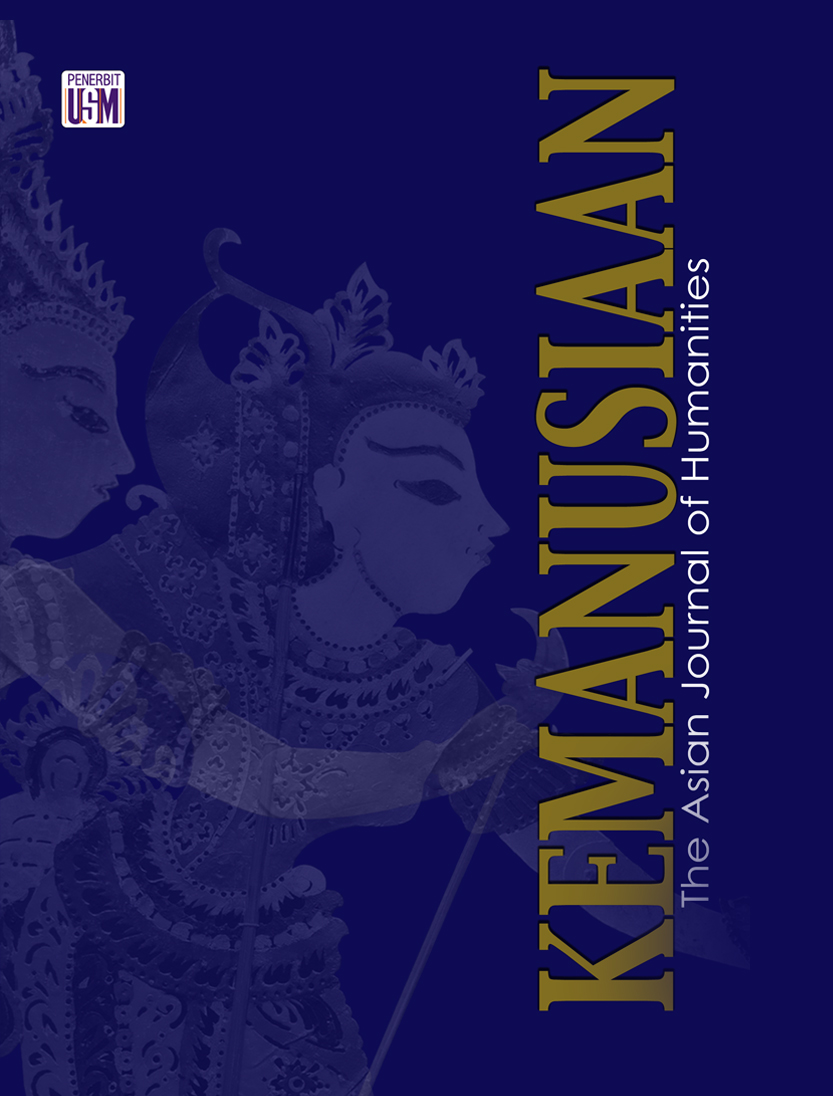KEMANUSIAAN
The Asian Journal of Humanities
Published by
Penerbit Universiti Sains Malaysia
| Past Issue - Volume 20, Number 2, 2013 |
- Through a Glass Darkly: A Fresh Look at the Stories of the Foundation of Singapore
Teddy Y.H. Sim
Abstract: The story of the founding of Singapore has typically been presented in a "simplistic" manner. This is perhaps understandable for school textbooks but less easy to fathom for specialist or semi-specialist works. Drawing upon sources that have been utilised in the past and those that have rarely been used, such as "The Sincere Letters", this study highlights the intricacies of the manoeuvrings of Stamford Raffles and the Malay rulers at specific junctures to re-evaluate the role of the major participants, particularly Raffles.
Keywords and phrases: Stamford Raffles, Singapore founding, Singapore history curriculum, early modern Malay politics, Tengku Long/Sultan Hussein
Download
- A Study on Salafi Jihadist Doctrine and the Interpretation of Jihad by Al Jama'ah Al Islamiyah
Zulkarnain Haron and Nordin Hussin
Abstract: The aim of this paper is to analyse the salafi jihadist doctrine and the concept of jihad as interpreted by the followers of the Al Jama'ah Al Islamiyah movement. Because this movement adopts the concept of da'wah wal jihad to achieve its mission, this paper will discuss the different views that exist in defining the concept of jihad qital (revolutionary jihad). The paper also explores how the salafi jihadist ideology penetrated this movement and the key salafist scholars who influenced its views. Some of the scholars who reinterpreted the boundaries and requirements of jihad have close links with the followers of Al Jama'ah Al Islamiyah. These scholars reject the traditional limitations of jihad, particularly in relation to the killing of Muslims and non-Muslims. In this sense, this group promotes a broader and more aggressive concept of jihad. Finally, this paper identifies radical elements within Al Jama'ah Al Islamiyah that reject the traditional definition of jihad and redefine global jihad in an attempt to justify more aggressive actions and accept collateral damage to people of their own religion.
Keywords and phrases: jihad, radicalism, terrorism, salafi, wahhabi
Download
- The Spread of Sarnath-Style Buddha Images in Southeast Asia and Shandong, China, by the Sea Route
Kang, Heejung
Abstract: Certain Buddhist statues discovered in Southeast Asia were sculpted after Sarnath-style sculptures. Thus, these statues were produced between the late fifth and early sixth centuries. Considering the sea route during that period, it was natural that Buddhist statues would be introduced from Sarnath to Funan in its prime via the Ganges and the Indian Ocean. Buddhist sculptures conveyed through that channel became the foundation for early Buddhist art in Southeast Asia. Based on the style created at Sarnath in India, this art is significant because it reveals the first stage of Buddhist art in Southeast Asia. These Buddhist sculptures reflect the Central and Southern Indian styles of the Gupta period. Hence, Buddhist art forms must have spread to Southeast Asia by different routes. Certain sculptures that were recently excavated in Shandong have no traces of drapery and have slender physical outlines. Such features were most likely influenced by styles employed in Sarnath Buddhist sculptures. These Shandong sculptures were most likely modelled after Buddhist statues discovered in Southeast Asian regions such as Thailand, Cambodia, and Vietnam, indicating that Central Indian Buddhist art was introduced earlier than Southern Indian art and conveyed from the Ganges to the South China Sea through the Gulf of Bengal via the sea routes. Thus, Southeast Asian Buddhist sculpture was the "missing link" that connected Central India to East China, and it was highly valuable as the first stage in the area.
Keywords and phrases: Sarnath-style, Buddhist statues in Shandong, Funan, sea route, Faxian, Indianisation
Download
- The Colonial Machinery's Marginalisation of Indian Women's Discourses by the Mutation of Socio-Linguistic Genes
Jai Singh
Abstract: Colonialism in general and British colonialism in particular, mutates sociolinguistic genes to suit its needs. British colonialism in India controlled and shaped the development and mutation of socio-linguistic genes both directly and indirectly. The transfer of written texts, oral narratives, and non-verbal expressions can be compared to the transfer of biological genes vertically from one generation to another and horizontally from one space to another. There are three possible situations: first, a gene may transfer as a dominant gene; second, a gene may not be transferred; third, a gene may be transferred, but only as a recessive gene. A similar situation occurred among women writers: many of them never reached the present generation, and those who did are not considered important writers because the British handed over authority only to socio-linguistically engineered Indians whose sensibilities were structured to reject all such discourses. Even during the struggle for freedom, women's issues remained fixed in remarkably similar schemes during the British period as one patriarchy confronted the other. In other words, the Indian patriarchal system, though outwardly opposed the British system, also marginalised the voices of independent women by depriving them of their livelihoods, and the British assisted in this with laws, police and discourse. Socio-linguistic engineering resembles genetic engineering in many respects, and this analogy can be used to study how the sensibilities of people are controlled.
Keywords and phrases: socio-linguistic genes, linguistic mutation, British colonialism, Muddupalani, Deleuze and Guattari
Download
Research Notes
- Javanese Names during the Height of the Hindu-Buddhist Kingdoms in Java: An Ethnolinguistic Study
Sahid Teguh Widodo


